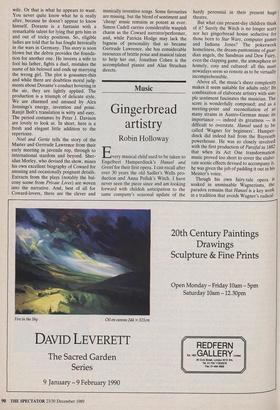M u si c
Gingerbread artistry
Robin Holloway
Every musical childused to be taken to Engelbert Humperdinck's Hansel and Gretel for their first opera. I can recall after over 30 years the old Sadler's Wells pro- duction and Anna Pollak's Witch. I have never seen the piece since and am looking forward with childish anticipation to the same company's seasonal update of the hardy perennial in their present huge theatre.
But what can present-day children think of it? Surely the Witch is no longer scary nor her gingerbread house seductive for those born to Star Wars, computer games and Indiana Jones? The pokerwork homeliness, the dream-pantomime of guar- dian angels, the Sandman and Dew Fairy, even the clapping game, the atmosphere so homely, cosy and cultured: ' all this must nowadays seem so remote as to be virtually incomprehensible.
Above all, the music's sheer complexity makes it seem suitable for adults only! Its combination of elaborate artistry with sim- ple sentiment fascinates the musician. The score is wonderfully composed; and as a meeting-point and reconciliation of so many strains in Austro-German music its importance — indeed its greatness — is difficult to overstate. Hansel used to be called 'Wagner for beginners'. Humper- dinck did indeed hail from the Bayreuth powerhouse. He was so closely involved with the first production of Parsifal in 1882 that when its Act One transformation music proved too short to cover the elabo- rate scenic effects devised to accompany it, hp was given the job of padding it out in his Meister's voice.
Though his own fairy-tale opera is soaked in unmissable Wagnerisms, the paradox remains that Hansel is a key work in a tradition that avoids Wagner's radical- ism altogether. This music flows from the well-springs of German diatonic folksong, both direct and as elaborated through Schubert, Weber, Mendelssohn, Schu- mann and Brahms, to end in the Mahler of the Knaben Wunderhorn and the simpler aspects of Wolf, Strauss and Pfitzner. Two extremes of style mingle here in happy union. The first is lowbrow — for instance, the luscious waltz-tune that evokes the house of sweeties and the exuberant one for the Witch's downfall, which do a Johann Strauss in excelsis (nor was the message lost on Richard, who conducted Hansel's premiere in 1893 and audibly never forgot it). The other is the 'sanc- tified' style, which with less unaffected treatment can easily become sanctimo- nious. The closing phrase from the chil- dren's prayer, so sweet and demure in its piety, becomes merely bombastic and in- sincere as blown up in the Resurrection chorus of Mahler's second symphony.
Most obviously Wagnerian is the Witch scene, the only stretch that tends slightly to outstay its welcome. Its source is mainly in Mastersingers, where the same reservation applies, on an enormously larger scale. Wagner's comedy invents at a stroke the golden busyness without which Hansel wouldn't be possible. Dare I say that I believe Humperdinck's is the better- composed of the two? Not just in the obvious superiority of its tunes (never Wagner's strong point even here where he actually needs them), nor in its better balance between length and musical con- tent, but above all in its degree of finish, the extraordinary high level of the craft- manship, that links him to Wagner's arch- enemy Brahms.
Hansel shows that Wagner can be well- written according to academic tenets that are far from stultified; that his harmony can be classicised, his orchestration ren- dered positively Dvorak-like in euphony; above all that the frequent uncouthness of Wagner's polyphonic leitmotivic coupling can be done with counterpoint so felici- tous that one sometimes blinks in aural amazement. I yield to none in admiration for Wagner's achievement, the greatest of its kind; but one can see how, from the grammarian's point of view, he might be thought to have 'ruined the art of music', as well as, from another, tastelessly ex- ploded music's expressive decorum. Han- sel and Gretel provides an unlikely as well as a delightful resolution of the notorious rift between conservative and progressive in late 19th-century German music, and in doing so shows it to be factitious. Long before Schoenberg, with mighty labour and dubious consequences, reconciled Brahms and Wagner, Humperdinck's so- called children's opera had done the same with easy grace.











































































































 Previous page
Previous page